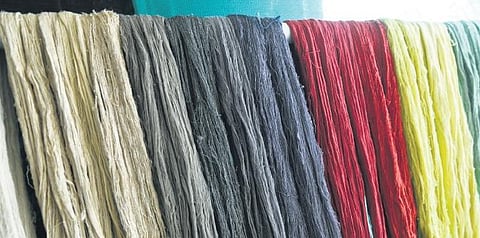

HYDERABAD: Handlooms hold a cherished place in the hearts of Indians, and the artisans responsible for infusing these fabrics with elegance and cultural flair deserve immense praise. Recently, Crafts Council Telangana (CCT) organised a workshop centered around the tie and dye process for looms. This event saw artisans from two Telugu states deeply engaged in exploring this art form. A team from Lucknow joined, bringing with them natural colour dyes that could transform the loom into a canvas of vibrant hues. During CE’s visit to the workshop, we conversed with Kusum Vishwanath, a member of Crafts Council Telangana, and Jagadha Rajappa, an independent expert in natural dyes, both of whom provided insights into the workshop’s objectives.
Kusum explained the rationale behind hosting this workshop, stating, “Our aim was to support the artisans — skilled weavers and dyers primarily from various districts in Telangana and Andhra Pradesh — who work with traditional dyes from regions like Pochampally, Puttapaka, Venkatagiri, among others. While many artisans are well-versed in the ancient techniques of natural dyeing, there’s a decline in interest due to its challenging nature, despite the environmental necessity.
To address this, AMA Herbals Pvt. Ltd., based in Lucknow, has innovated powdered natural dyes derived from entirely natural sources, mirroring our traditional dye-making process. These dyes, packaged and sold, require a specific method for application — more than just a simple dip-and-use approach. This workshop focuses on teaching this intricate process, exploring nine colours suited for silk and cotton. Each hue demands a meticulous three-hour dyeing process before the yarn is dried and readied for loom weaving, culminating as the final step in this fundamental procedure.”
Regarding the participation, she mentioned, “We had approximately 25 artisans attending the three-day workshop. It offered them an opportunity to immerse themselves in the learning process, engage in interactive Q&A sessions to address any doubts related to the techniques involved. These artisans, steeped in the tradition of weaving and dyeing, will also provide valuable feedback. Once they’ve completed the yarn dyeing process during the workshop, they’ll return to apply these powdered colours in their craft.”
Speaking about the process, Jagadha Rajappa explained, “The yarn undergoes various stages before reaching its final form. It begins with savouring, followed by mordanting, tanning, dye extraction, dyeing, fixing, and final rinsing, representing the traditional methods.
However, in this workshop, to streamline and reduce the manual labour for artisans, everything has been extracted and prepared in powdered form. There’s a pretreatment process, condensed into powder or liquid forms. Once utilized, the process follows the cycle I mentioned earlier. While this entire process here takes three to four hours, traditionally, it would demand a minimum of four to five days. Responding to artisans’ demand for powdered extraction, CCT collaborated to facilitate this innovation, albeit it took some time to mobilise and bring it to fruition.”
“These colours are derived from flowers and fruits, enriching the yarn used in your clothes and intricate crafts,” she adds, highlighting their organic source and contribution to the vibrance of textiles.